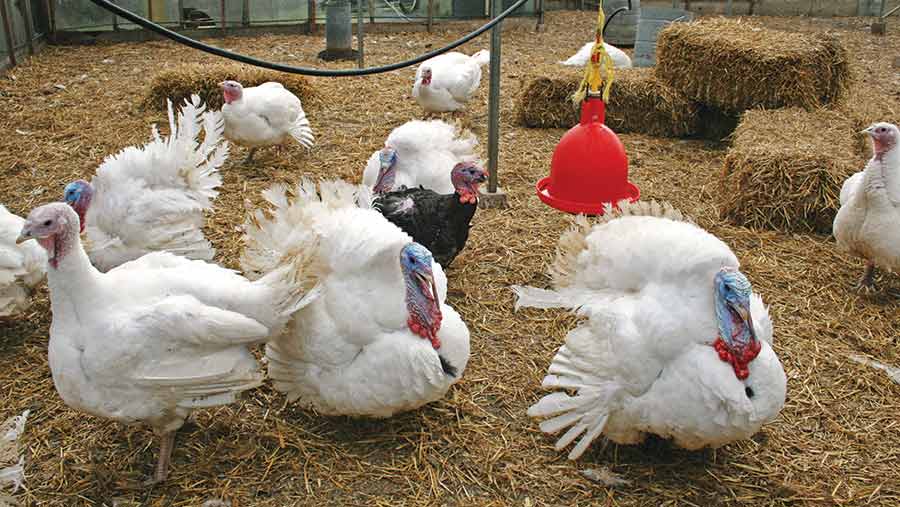Producer puts greenhouse to clever use to market turkeys

A combination of clever management and intelligent marketing are proving a recipe for success for one Lancashire-based turkey farmer.
Fresh air and good marketing may seem an incongruous partnership but according to Lancashire turkey producer John Woods they have a vital role to play at both ends of the production cycle.
His family-run business, Woods Farm Fresh Turkeys, rears about 3,000 birds for the Christmas trade at Springfield Farm, Little Hoole near Preston, Lancashire.
The Woods family have been rearing turkeys for 35 years but, like many others who are producing at this level, they know they are in an increasingly tough market that’s facing pressure from cheap imported turkeymeat.
“We have a solid seasonal clientele for our birds, ranging from individual customers to butchers who take several hundred birds – but the market is getting very competitive.
“There’s still a strong demand for quality turkeys produced on this scale by family-run businesses, particularly from individual customers, who want to know where their bird has come from and how it has been reared,” says Mr Woods, who runs the business with his wife Cathy and sons Danny and Ben.
Marketing
As well as creating an informative website, the family took the decision last Christmas to invest in advertising space in the local newspaper. It was the first time in the business’ 35-year history.
“The response was unbelievable, and proved to us there’s a bigger demand for top-quality birds than we’d realised, despite all the cheap imported rolled joint and breast meat that’s heavily promoted at Christmas time.
“So marketing is now very much high on our list of priorities for the future,” says Mr Woods.
The farm, which also produces tomatoes from under an acre of glass, as well as beef and pigs, opened a farm shop three years ago.
The busy butcher’s counter provides another useful opportunity to market the family’s turkeys, which are available for several months of the year.
The greenhouses, once emptied of tomatoes, prove an excellent rearing space – one visitors to the farm shop can see straight into.
“It might seem unusual but the birds do really well in the greenhouse. We move some of them in at about 12 weeks old and put straw around the feeding areas. Customers to the farm shop see them in the greenhouse, so it’s a great way to promote them – and they love to see them dust-bathing on the earth floor.”
Both white and bronze birds are reared and are bought as day-olds – about an 80:20 split.
“Demand for bronze birds has fluctuated in recent years. Five years ago we were selling more and more, then things eased off, but last year demand was back up again.
“Being in turkey production is like living life at the casino. Every Christmas you never know how the dice are going to fall. But last year our birds were much bigger – about 0.9kg a bird on average – mainly because of the really good autumn weather.
“We rear in traditional wooden buildings so the birds really thrived in the higher temperatures in the run-up to Christmas.”
Brooding
Day-olds arrive from July to mid-August. Chicks are reared in surrounds in groups of about 500 using gas brooders.
After four weeks the birds are moved into bigger areas but other farmers buying poults from the farm now have to wait until the birds are carrying more feather.
“If young birds are moved into cold accommodation when they haven’t enough feather there will be losses so we now ask our poult customers to wait until they are about six weeks old.”
But the rearing ethic of this business is very much about providing birds at all stages of their development with a natural and healthy environment – and it’s something that Mr Woods believes is becoming increasingly important to consumers buying direct from producers.
A new building is used for day-olds up to about four weeks. It’s unconventional but is proving highly successful.
With its 6ft-high shuttered concrete walls topped by Yorkshire boarding, it is providing an ideal environment with ample ventilation.
“The birds rear really well in here in the summer. We do have to use more gas to maintain the heat but the big advantage is the Yorkshire boarding which provides plenty of fresh air and ensures good, natural ventilation.
“Like all turkey producers we’ve had our share of problems with diseases over the years but since we’ve been able to prove young birds with this natural source of fresh air we’ve had no health issues.”
The white birds are moved to a barn-reared system while the bronze turkeys are reared on free-range and housed in wooden sheds on range. But care has to be taken to ensure feed intakes are maintained.
Right diet
“We lock up all the free-range birds at night before it goes dark – not just for safety but also to make sure they eat enough from the feeders.
“And we don’t open them up in the morning until we know they’ve had time to feed. If you don’t have a routine, free-range birds will spend more time foraging outside rather than eating their rations.
“The better the weather the more time they are outside and the less they eat.”
The business produces from 4.5kg birds up to 18kg-plus birds for the catering trade – last year’s heaviest bird was over 27kg.
“We’ve got to make sure we can compete in the marketplace by offering top-quality birds reared to a high standard so that we appeal to those consumers who want British-reared turkey.
“But you’ve got to make sure you market your birds as well as you possibly can. The demand is there, but you’ve got to go out and shout about the quality of the turkeys you’re producing,” says Mr Woods.
